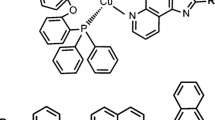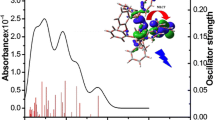Abstract
Two copper(I) complexes [Cu(Pyz-Phen)2]PF6 (1) and [Cu(POP)(Pyz-Phen)]PF6 (2) (Pyz-Phen = pyrazino[2,3-f] [1, 10]phenanthroline, POP = bis[2-diphenylphosphino]-phenyl]ether) have been synthesized and characterized. The photophysical properties of these complexes in solution have been studied. The electronic absorption spectrum of complexes 1 exhibit the lowest-lying MLCT absorption band at 459 nm and high-energy ligand-based transitions at 275 nm, while that of complex 2 exhibits the MLCT/LLCT band at 400 nm and ligand π-π* band at 262 nm. In addition, both 1 and 2 show similar phosphorescence 3MLCT/3LLCT emissions with maximum emission wavelengths of 569 and 572 nm, respectively. Density functional theory (DFT) and time-dependent density functional theory (TDDFT) were employed to rationalize the photophysical properties of the complexes studied. The theoretical data confirm the assignment of the experimental absorption spectra and the nature of the emitting states.

Photophysical properties of copper(I) complexes containing pyrazine-fused phenanthroline ligands









Similar content being viewed by others
References
McMillin DR, Buckner MT, Ahn BT (1977) A light-induced redox reaction of bis (2, 9-dimethyl-1, 10-phenanthroline) copper(I). Inorg Chem 16(4):943–945. doi:10.1021/ic50170a046
Funaki T, Funakoshi H, Kitao Onozawa-Komatsuzaki ON, Kasuga K, Sayama K, Sugihara H (2012) Cyclometalated ruthenium (II) complexes as near-IR sensitizers for high efficiency dye-sensitized solar cells. Angew Chem Int Ed 51(30):7528–7531. doi:10.1002/anie.201108738
Bolink HJ, Cappelli L, Coronado E, Gavina P (2005) Observation of electroluminescence at room temperature from a ruthenium(II) bis-terpyridine complex and its use for preparing light-emitting electrochemical cells. Inorg Chem 44(17):5966–5968. doi:10.1021/ic0507058
Wong KMC, Chan MMY, Yam VWW (2014) Supramolecular assembly of metal-ligand chromophores for sensing and phosphorescent OLED applications. Adv Mater 26(20):5558–5568. doi:10.1002/adma.201306327
Kumar P, Bansiwal A, Labhsetwar N, Jain SL (2015) Visible light assisted photocatalytic reduction of CO2 using a graphene oxide supported heteroleptic ruthenium complex. Green Chem 17(3):1605–1609. doi:10.1039/c4gc01400f
McMillin DR, Kirchhoff JR, Goodwin KV (1985) Exciplex quenching of photo-excited copper complexes. Coord Chem Rev 64(4):83–92. doi:10.1016/0010-8545(85)80043-6
Kober EM, Caspar JV, Lumpkin RS, Meyer TJ (1986) Application of the energy gap law to excited-state decay of osmium(II)-polypyridine complexes: calculation of relative nonradiative decay rates from emission spectral profiles. J Phys Chem 90(16):3722–3734. doi:10.1021/j100107a046
Armaroli N, Accorsi G, Holler M, Moudam O, Nierengarten JF, Zhou Z, Wegh RT, Welter R (2006) Highly luminescent Cu(I) complexes for light-emitting electrochemical cells. Adv Mater 18(10):1313–1316. doi:10.1002/adma.200502365
Zhang QS, Zhou QG, Cheng YX, Wang LX, Ma DG, Jing XB, Wang FS (2006) Highly efficient electroluminescent from gree-light emitting electrochemical cells based on Cu complexes. Adv Funct Mater 16(22):1203–1208. doi:10.1002/adfm.200500691
Wei FX, Fang L, Huang Y (2010) Synthesis, characterization, crystal structures, and photophysical properties of a series of room-temperature phosphorescent copper(I) complexes with oxadiazole-derived diimine ligand. Inorg Chim Acta 363(11):2600–2605. doi:10.1016/j.ica.2010.04.041
Ichinaga AK, Kirchhoff JR, McMillin DR, Dietrich-Buchecker CO, Marnot PA, Sauvage JP (1987) Charge-transfer absorption and emission of Cu(NN)2+ systems. Inorg Chem 26:4290–4292. doi:10.1021/ic00272a030
Cunningham CT, Cunningham KLH, Michalec JF, McMillin DR (1999) Cooperative substituent effects on the excited states of copper phenanthrolines. Inorg Chem 38(20):4388–4392. doi:10.1021/ic9906611
Vogtle F, Luer I, Balzani V, Armaroli N (1991) Endoreceptors with convergent phenanthroline units: a molecular cavity for six guest molecules. Angew Chem Int Ed 30(10):1333–1336. doi:10.1002/anie.199113331
Kern JM, Sauvage JP, Weidmann JL, Armaroli N, Flamigni L, Ceroni P, Balzani V (1997) Complexes containing 2,9-bis(p-biphenylyl)-1,10-phenanthroline units incorporated into a 56-membered ring. synthesis, electrochemistry, and photophysical properties. Inorg Chem 36(23):5329–5338. doi:10.1021/ic970707v
Cuttell DG, Kuang SM, Fanwick PE, McMillin DR, Walton RA (2001) Simple Cu (I) complexes with unprecedented excited-state lifetimes. J Am Chem Soc 124(1):6–7. doi:10.1021/ja012247h
McCusker CE, Castellano FN (2013) Design of a long-lifetime, earth-abundant, aqueous compatible Cu(I) photosensitizer using cooperative steric effects. Inorg Chem 52(14):8114–8120. doi:10.1021/ic401213p
Bozic-Weber B, Constable EC, Furer SO, Housecroft CE, Troxler LJ, Zampese JA (2013) Copper(I) dye-sensitized solar cells with [Co(bpy)3] 2+/3+ electrolyte. Chem Commun 49(65):7222–7224. doi:10.1039/c3cc44595j
Sandroni M, Kayanuma M, Planchat A, Szuwarski N, Blart E, Pellegrin Y, Daniel C, Boujtita M, Odobel F (2013) First application of the HETPHEN concept to new heteroleptic bis(diimine) copper(I) complexes as sensitizers in dye sensitized solar cells. Dalton Trans 42(30):10818–10827. doi:10.1039/c3dt50852h
Wen CH, Tao GQ, Xu XH, Feng XQ, Luo RC (2011) A phosphorescent copper(I) complex: synthesis, characterization, photophysical property, and oxygen-sensing behavior. Spectrochim Acta A 79(5):1345–1351. doi:10.1016/j.saa.2011.04.067
Li Z (2011) Synthesis, characterization and theoretical analysis on a oxygen-sensing phosphorescent copper(I) complex. 81(1) 475–480. doi: 10.1016/j.saa.06.040
Frisch MJ, Trucks GW, Schlegel HB, Scuseria GE, Robb MA, Cheeseman JR, Scalmani G, Barone V, Mennucci B, Petersson GA, Nakatsuji H, Caricato M, Li X, Hratchian HP, Izmaylov AF, Bloino J, Zheng G, Sonnenberg JL, Hada M, Ehara M, Toyota K, Fukuda R, Hasegawa J, Ishida M, Nakajima T, Honda Y, Kitao O, Nakai H, Vreven T, Montgomery JJA, Peralta JE, Ogliaro F, Bearpark M, Heyd JJ, Brothers E, Kudin KN, Staroverov VN, Kobayashi R, Normand J, Raghavachari K, Rendell A, Burant JC, Iyengar SS, Tomasi J, Cossi M, Rega N, Millam NJ, Klene M, Knox JE, Cross JB, Bakken V, Adamo C, Jaramillo J, Gomperts R, Stratmann RE, Yazyev O, Austin AJ, Cammi R, Pomelli C, Ochterski JW, Martin RL, Morokuma K, Zakrzewski VG, Voth GA, Salvador P, Dannenberg JJ, Dapprich S, Daniels AD, Farkas O, Foresman JB, Ortiz JV, Cioslowski J, Fox DJ (2009) Gaussian 09, revision A. Gaussian Inc, Wallingford
Runge E, Gross EK (1984) Density-functional theory for time-dependent systems. Phys Rev Lett 52:997–1000. doi:10.1103/physrevlett.52.997
Mayo SL, Olafson BD, Goddard WA (1990) DREIDING: a generic force field for molecular simulations. J Phys Chem 94(26):8897–8909. doi:10.1021/j100389a010
Hariharan PC, Pople JA (1974) Accuracy of AHn equilibrium geometries by single determinant molecularorbital theory. Mol Phys 27(1):209–214. doi:10.1080/00268977400100171
Hay PJ, Wadt WR (1985) Ab initio effective core potentials for molecular calculations. potentials for the transition metal atoms Sc to Hg. J Chem Phys 82(8):270–283. doi:10.1063/1.448799
Wadt WR, Hay PJ (1985) Ab initio effective core potentials for molecular calculations. potentials for main group elements Na to Bi. J Chem Phys 82(1):284–298. doi:10.1063/1.448800
Costa RD, Tordera D, Orti E, Bolink HJ, Schonle J, Graber S, Housecrof CE, Constable EC, Zampese JA (2011) Copper(I) complexes for sustainable light-emitting electrochemical cells. J Mater Chem 21(8):16108–16118. doi:10.1039/c1jm12607e
Fraser MG, van der Salm H, Cameron SA, Blackman AG, Gordon KC (2013) Heteroleptic Cu(I) bis-diimine complexes of 6,6′-dimesityl-2,2′-bipyridine: a structural, theoretical and spectroscopic study. Inorg Chem 52(6):2980–2992. doi:10.1021/ic302393p
Hsu CW, Lin CC, Chung MW, Chi Y, Lee GH, Chou PT, Chang CH, Chen PY (2011) Systematic investigation of the metal-structure photophysics relationship of emissive d10-complexes of group 11 elements: the prospect of application in organic light emitting devices. J Am Chem Soc 133(9):12085–12099. doi:10.1021/ja2026568
Bozic-Weber B, Chaurin V, Constable EC, Housecroft CE, Meuwly M, Neuburger M, Rudd JA, Schonhofer E, Siegfried L (2012) Exploring copper(I)-based dye-sensitized solar cells: a complementary experimental and TD-DFT investigation. Dalton Trans 41:14157–14169. doi:10.1039/c2dt31159c
Casida ME, Jamorski C, Casida KC, Salahub DR (1998) Molecular excitation energies to high-lying bound states from time-dependent density-functional response theory: characterization and correction of the time-dependent local density approximation ionization threshold. J Chem Phys 108(11):4439–4449. doi:10.1063/1.475855
Stratmann RE, Scuseria GE, Frisch MJ (1998) An efficient implementation of time-dependent density-functional theory for the calculation of excitation energies of large molecules. J Chem Phys 109(19):8218–8224. doi:10.1063/1.477483
Perdew JP, Burke K, Emzerhof M (1996) Generalized gradient approximation made simple. Phys Rev Lett 77(8):3865–3868. doi:10.1103/PhysRevLett.77.3865
Perdew JP, Burke K, Emzerho FM (1997) K+ emission in symmetric heavy ion reactions at subthreshold energies. Phys Rev Lett 78(7):1396–1396. doi:10.1103/PhysRevLett.78.1396
Lu T, Chen FW (2012) Multiwfn: a multifunctional wavefunction analyzer. J Comput Chem 33(5):580–592. doi:10.1002/jcc.22885
Hiort C, Lincoln P, Norden B (1993) DNA binding of Δ- and Δ-[Ru(phen)2DPPZ]2+. J Am Chem Soc 115(9):3448–3454. doi:10.1021/ja00062a007
Sun PP, Duan JP, Lih JJ, Cheng CH (2006) Synthesis of new europium complexes and their application in electroluminescent devices. Adv Funct Mater 13(9):683–691. doi:10.1002/adfm.200304378
Martin RL (2003) Natural transition orbitals. J Chem Phys 118:4775–4777. doi:10.1063/1.1558471
Yanai T, Tew DP, Handy NC (2004) A new hybrid exchange–correlation functional using the Coulomb-attenuating method (CAM-B3LYP). Chem Phys Lett 393:51–57. doi:10.1016/j.cplett.2004.06.011
Huang SP, Zhang QS, Shiota Y, Nakagawa T, Kuwabara K, Yoshizawa K, Adachi C (2013) Computational prediction for singlet- and triplet-transition energies of charge-transfer compounds. J Chem Theory Comput 9:3872–3877. doi:10.1021/ct400415r
Xu SX, Wang JL, Xia HY, Zhang F, Wang YB (2014) Computational prediction for emission energy of iridium (III) complexes based on TDDFT calculations using exchange-correlation functionals containing various HF exchange percentages. 21: 22–24. doi: 10.1007/s00894-014-2557-1
Lowry MS, Hudson WR, Pascal RA Jr, Bernhard S (2004) Accelerated luminophore discovery through combinatorial synthesis. J Am Chem Soc 126:14129–14135. doi:10.1021/ja047156+
Vlcek A, Zalis S (2007) Modeling of charge-transfer transitions and excited states in d6 transition metal complexes by DFT techniques . Coord Chem Rev 251:258–287. doi:10.1016/j.ccr.2006.05.021
Acknowledgments
The authors acknowledge financial support by the National Natural Science Foundation of China (No.21462020, 21443010, and 21563013) and Jiangxi Science and Technology Normal University Key Laboratory of Organic-inorganic Composite Materials (Key training base). They thank the Guizhou University High Performance Computation Chemistry Laboratory (GHPCC) for help with computational studies.
Author information
Authors and Affiliations
Corresponding authors
Rights and permissions
About this article
Cite this article
Xu, S., Wang, J., Zhao, F. et al. Photophysical properties of copper(I) complexes containing pyrazine-fused phenanthroline ligands: a joint experimental and theoretical investigation. J Mol Model 21, 313 (2015). https://doi.org/10.1007/s00894-015-2857-0
Received:
Accepted:
Published:
DOI: https://doi.org/10.1007/s00894-015-2857-0




